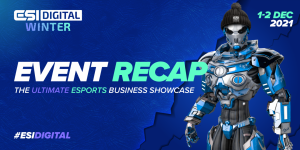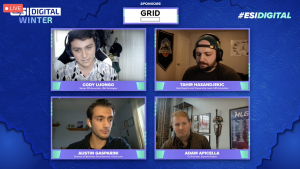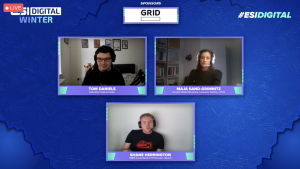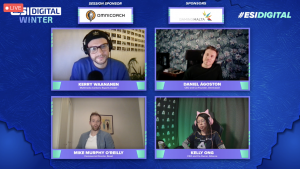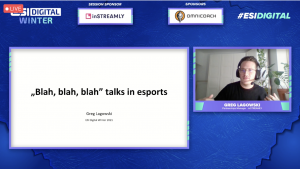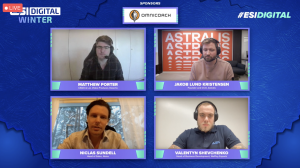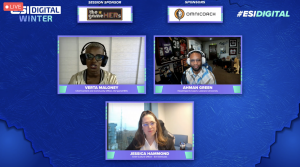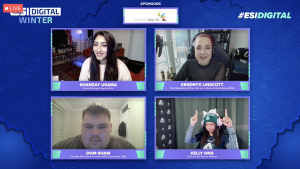Yesterday, Esports Insider concluded its final event of the year as over 170 virtual attendees opened their laptops to take part in ESI Digital Winter.
With topics ranging from fan engagement to esports ecosystems, experts from across the industry collated to discuss some of the sector’s major talking points.
For those who were unable to attend the conference, Esports Insider has compiled some of the biggest takeaways from the event. Before jumping into the article, many thanks go to our Gold Partner GRID Esports and Silver Partners Omnicoach and Nuvei for sponsoring the digital conference.
We suggest reading the below to the tune of the official ESI Digital Winter Spotify playlist, via our partnership with Game Ready Music.
Sue ‘Smix’ Lee joins the ESI Hall of Fame
Perhaps one of the major takeaways from ESI Digital Winter was the induction of RTS’ Vice President of Talent Management, Sue ‘Smix’ Lee, into the ESI Hall of Fame.
Announced as the sole member of ESI’s Class of 2021, which was sponsored by Gaming Malta, Lee spoke to esports host Adam Savage about her journey, ventures and successes.
Lee said: “I’m not gonna lie, none of it was meticulously planned. I always just feel like I was at the right place at the right time. It was truly just a hobby of mine and I never thought it would get anywhere.
“I never imagined that gaming would allow me to actually enter the space and discover different jobs that would allow me to make a living.”
Lee joins the likes of Complexity Gaming CEO, Jason Lake, Riot Games’ Global Head of League of Legends Esports, Naz Aletaha, Vindex CEO Mike Sepso, OpTic Gaming CEO Hector Rodriguez, among others in ESI’s Hall of Fame.
The many, not the few
RELATED: ESL Gaming partners with 343 Industries for Halo esports programme
As esports continues to develop, it’s important to always take into account and discuss different esports ecosystems. This could be with regards to a title’s specific esports structure or even a country’s approach to the industry.
When highlighting title-specific esports divisions during ESI’s ‘The Many, not the Few’ panel, Tahir Hasandjekic, Halo Esports and Viewership Lead, 343 Industries, emphasised the need for publisher inclusion. He said: “For very long term success, the publisher has to be involved in some way or another. For us, the HCS today is us realising kind of what our role in the ecosystem is.”
Moreover, Adam Apicella, Co-Founder & President of Esports Engine, commented on esports’ untapped potential: “Esports has had crazy success, a crazy trajectory, and we have nowhere near the resources or foundations we need to truly grow. Once it’s there, this space is going to be the biggest competitive sport in the world.”
With regards to local esports ecosystems, Icelandic Esports Association’s Chairman Ólafur Hrafn Steinarsson discussed the country’s initiatives that are being implemented. During the ‘Thinking Local, Going Global’ panel, he detailed: “We now have over 2.6 percent of kids in the country paying to train in esports. We have 20 Professional youth esports coaches. We have around 10 percent of the country tuning in to esports content every month.”
You can read more about Iceland’s esports ecosystem here.
An Emphasis on Peripherals
The esports peripheral market is growing at a rapid pace, and there seems to be a new competitor to the established brands like HyperX, Razer and Corsair, every other month. Maja Sand-Grimnitz, Director of Global Marketing at EPOS, likened the market situation to “the wild west.”.
Shane Herrington, Head of PR and Social Media HyperX EMEA, added that the market is yet to peak: “It’s definitely growing, and I definitely don’t think it’s peaked yet. It’s exciting to see how many more brands can fit into these spots. It’s all about differentiation.”
Herrington added that due to the fact that the gaming audience is so vocal, brands are able to adjust to see what the consumer wants. If something doesn’t work, every brand knows it via their social channels.
The cruciality of fan engagement
RELATED: The new in-game advertising gold mine — Omnicoach
Day One of ESI Digital Winter finished off by discussing all things fan engagement. The panel, sponsored by Omnicoach, highlighted an array of topics such as the gaps in currently available tech when it comes to measuring impact from campaigns, especially in the long term.
Mike Murphy O’Reilly, Commercial Director of Reset, highlighted that above all else it is important to find out where your audience is coming from. He explained: “If you find somebody who sponsors a basketball, football or cricket team — their engagement is typically limited to platforms like Facebook, Instagram, Twitter, and increasingly TikTok.
“When it comes to esports what you find is usually engagement happens on those platforms and you can track fans across them. But, the majority of that conversation takes place on platforms like Twitch, Discord, Reddit, Weibo, depending on what their business is and who you’re going after.”
The session concluded with a lively discussion over the ‘man vs machine’ debate’. In particular, whether brands can justify the costs of either hiring an employee or spending nearly the same amount on reporting software that esports companies use.
Selling sponsorships
The start of the second day of ESI Digital Winter started with a sponsored presentation from Greg Lagowski, Partnerships Manager at inSTREAMLY. After speaking highly of esports numbers, Greg noted that, although selling esports to sponsors might sound easy, it’s easy to be mistaken.
His advice was: “Be transparent, care about your reach and know your capability. Secondly, manage expectations wisely and don’t overpromise. Another thing is to create a brand that your community will love, not only based on sports performance goals. Remember, content community and entertainment.
“Don’t be afraid of talking with your audience, don’t be so official in your communication. Understand the preferences of your community, do the research. Be where the attention of your community is!”
The state of CS:GO and Smite
RELATED: 99Liga and ESL Meisterschaft merge to form new DACH CS:GO league
The second day of ESI Digital Winter showcased two very different esports stories – Smite and CS:GO.
Smite’s fifth season was probably the “worst year ever” for the third-person MOBA, Auverin Morrow, the Esports Brand Manager for Hi-Rez Studios, confessed at ESI Digital Winter. The viewership numbers were down, the number of leagues was too high, and players simply weren’t happy. Smite had to make drastic changes.
Alex Cantatore, the Brand Director for Hi-Rez noted: “We wanted to be able to plan a Smite Pro League that is entirely player-focused, and with this new model players receive the 100 per cent of revenue they generate. They are responsible for the rosters themselves. It’s letting the players run the league and feel like they are in control.
In the panel discussing the future of CS:GO, the prevailing opinion is that the game is going in the right direction. However, the CS:GO landscape was challenging for teams to remain competitive during the ‘online era’, which took place in 2020 and most of 2021.
Jakub Lund Kristensen, Founder and CCO of Astralis, noted: “It was one of the biggest curveballs we’ve ever been served. We’ve spent years building the best possible machinery to perform on a big stage, and all of a sudden you were practising for six hours at home, you took a cup of coffee and you came back and all of a sudden you’re playing for 250 thousand dollars.
The elephant in the room was, of course, VALORANT. Although most of the panellists agree that the Riot Games title is “no competition” to CS:GO, it really does remain to be seen how Riot Games’ support will shape the FPS landscape in 2022 and later. The VALORANT panel echoed the sentiment as well.
Collegiate Esports’ rise
With every passing conference the topic of collegiate esports, particularly in the US, continues to gain more prominence. However, whilst the sector continues to develop, it’s crucial that all communities gain the opportunity to take part in this blossoming industry.
Speaking during the conference’s panel dedicated to the topic, Jessica Hammond, Evil Geniuses’ Chief Culture Officer highlighted that to help develop collegiate esports teams for communities it is important to start early. She said: “We have to work with the kids when they’re younger before they even get to college.
“It’s creating a mindset, it’s shaping behaviour, it’s all about that discipline and that rigour. If you can start that earlier on, it’s not an issue when they get to college. I think the biggest shift is we’re moving esports to a true sport.”
Lakeland University’s Head Esports Coach, Ahman Green, added that it’ll take universities and other education establishments to come together in order to support all communities wanting to pursue esports. Green also detailed that providing esports opportunities after college is also a great incentive to attract communities.
He said: “As a head coach, I’m hiring student employees. I’m gonna make a concerted effort to know that I keep a good motley crew of different backgrounds of student employees and student coaches as well.”
Discussing diversity
RELATED: Nicole LaPointe Jameson joins the*gameHERs Board of Advisors
The final panel of ESI Digital Winter provided an in-depth— and at some points reflective — look into diversity within the esports industry.
Throughout the panel, which was moderated by Square Enix Brand Manager, Shanzay Usama, experts highlighted the importance of EDI (Equality, Diversity and Inclusion) initiatives in esports. The diversity track, which also included the collegiate panel, was sponsored by women-led gaming community the*gameHERs.
Kendryx Linscott, Chief Marketing Officer for Women in Games International (WIGI), highlighted: “If you’re in the position to be hiring, or you’re in a position where you can give input into the hiring process, the first step is understanding what barriers exist in your language.
“What do your job descriptions look like? Who’s the hiring manager? Does the hiring manager have EDI concepts in their mind when they’re having these conversations?”
Kelly Ong, Co-Owner of Alliance, also detailed the overall benefits of having a diverse workforce with different backgrounds as it provides a good understanding of what is “right or wrong, per se, on a global market”.
To conclude, Dom Shaw, EDI Coordinator for UKIE, expressed that research is key when it comes to diversity in esports, particularly for an individual looking to get into the sector. He said: “You want to feel like you can join a company and feel part of it. I think it does take that research.”


